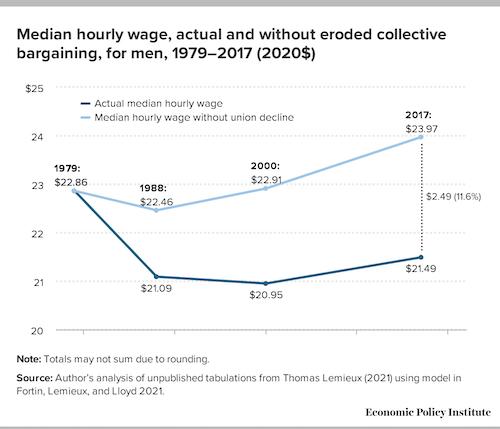The cost of declining union membership has been extraordinarily high for both union and nonunion workers, a new study found.
 |
Because more men than women were union members in 1979, the decline has been especially harmful to men’s wages. However, current trends show that broadening unionization would benefit women at least as much as men.
Image credit: EPI |
The report from the Economic Policy Institute found that the erosion of collective bargaining has been a driving factor depressing wage growth for middle earners over the last four decades. And that same inability to join together at work is also a major factor influencing the growth of wage inequality.
“These findings show once again that unions are the best check on corporate greed,” said International President Lonnie R. Stephenson. “When workers have a voice on the job, it benefits everyone, not just union members.”
The report, authored by EPI’s Distinguished Fellow Lawrence Mishel, states that the decades-long erosion in union membership has lowered the median hourly wage by $1.56, a 7.9% decline from 1979 to 2017. These losses equate to about $3,250 annually for a full-time, full-year worker.
“For decades, the erosion of collective bargaining was a major factor depressing wage growth for the typical worker and driving the growth of wage inequality. But this decline of unions wasn’t inevitable—it was a deliberate policy choice made on behalf of wealthy interests and corporations, and it can be reversed,” Mishel said. “Rebuilding collective bargaining is a necessary component of any policy agenda to reestablish robust wage growth for the vast majority of workers in the United States.”
In 1979, 27% of working people were covered by a contract they had bargained for. By 2019, that share had dropped to just 11.6%. Not coincidentally, that time period is also when income inequality widened to levels not seen in decades. According to another EPI report, the top 1% of Americans made 26.3 times as much income as the bottom 99% in 2015. Put another way, this rarified group of rich Americans took home more than 22% of all income – the highest share since a peak of 23.9% just before the Great Depression in 1928.
Mishel also noted that, because more men than women were union members in 1979, that the decline has been especially harmful to men’s wages. At that time, 31.5% of men were covered by collective bargaining versus 18.8% of women. However, current trends show that broadening unionization would benefit women at least as much as men.
The report, released in April, also pointed to research on the “spillover effects” of unionization on nonunionized workers, finding that, when the share of workers who are union members is relatively high, as it was in 1979, wages of nonunion workers are also higher. Had private-sector union density in 2013 remained at its 1979 level, weekly wages of nonunion men in the private sector would have been 5% higher, the equivalent of an additional $2,704 in earnings for year-round workers.
“This research demonstrates that the erosion of collective bargaining has been the largest single factor driving a wedge between middle- and high-wage male workers,” the report stated.
In another study by Mishel, co-authored by the EPI’s director of research Josh Bivens, found that workers would be making $10 more an hour if their wages had kept up with increases in productivity. The authors state that, when policies were oriented toward sharing productivity growth across income classes, wages kept up. But when the policies shifted – more toward employers, and at the expense of their employees – wages faltered. Among those policy shifts is the erosion of collective bargaining.
All this comes at a time when multiple research studies are showing that support for unions is strong. Almost half of all workers would join a union if they could, one study found. And Gallup’s 2020 poll put union support at 65%, the highest in a decade.
“Unions disproportionately benefit workers with low and moderate wages, workers with lower levels of education, and Black and Brown workers. Collective bargaining not only benefits union workers, but nonunion workers as well by raising wage standards across industries,” Mishel said. Policymakers, he continued, “must urgently restore workers’ freedom to form a union, and that includes passing the Protecting the Right to Organize Act.”
The PRO Act is major, comprehensive legislation that would make it easier for working people to join a union, while also increasing penalties for employers who try to stand in their way. It passed the House of Representatives in March, and has the support of President Joe Biden, but faces an uphill battle in the Senate.
Call your senators and encourage them to pass the PRO Act today. Find contact information at this link.